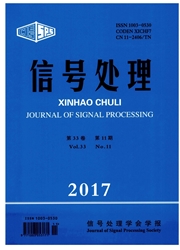

 中文摘要:
中文摘要:
作为压缩感知理论的前提,稀疏表示要求信号本身是稀疏的或者在某种正交基下可以稀疏表示.本文针对信号本身及小波变换后均不够稀疏的情况,提出一种基于模极大值点的信号稀疏表示算法.该算法在小波变换的基础上,利用小波分解的结构,对各层高频小波系数通过寻找其模极大值点的方法进行稀疏化,然后通过测量矩阵得到它的测量值,对测量点数进行熵编码以实现数据压缩传输.解码时,采用正交匹配追踪算法得到模极大值点的估计值,最后通过交替投影法重构出原信号.仿真结果表明,与经典压缩感知算法相比,该算法恢复信号的质量有较大提高,且由于稀疏度增大,所以信号具有更好的可压缩性,实验表明本文算法对复杂信号效果更明显.
 英文摘要:
英文摘要:
As a basic requirement of compressed sensing theory,sparse representation requires that a signal is sparse itself or it can be sparsely represented in some orthogonal basis.A new sparse representation algorithm based on modulus maxima is proposed for the signals that are non-sparse themselves and cannot be sparsely represented by wavelet transform.According to the structure of the wavelet transform,the high frequency coefficients of every level could be represented more sparsely via the method of modulus maxima searching.Then the measurement matrix could be applied to the sparse coefficients to obtain the measurement values.Entropy encoding of the measurement values is followed for data compression and transmission.For the decoding,orthogonal matching pursuit algorithm is used for recovering the modulus maxima of every level.Then the original signal is reconstructed by alternating projection algorithm.Compared with the classical compressed sensing algorithm with wavelet transform,simulation results show that since the sparsity of the wavelet coefficients is significantly improved according to our proposed algorithm,the compression ratio could be improved.Also,our proposed algorithm significantly improves the quality of the reconstructed signal,especially for the complex signal.
 同期刊论文项目
同期刊论文项目
 同项目期刊论文
同项目期刊论文
 An Improved Sparsity Adaptive Matching Pursuit Algorithm for Compressive Sensing Based on Regularize
An Improved Sparsity Adaptive Matching Pursuit Algorithm for Compressive Sensing Based on Regularize 期刊信息
期刊信息
